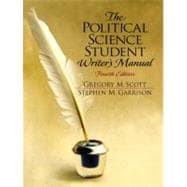
| To the Student | v | ||||
| To the Teacher | vii | ||||
| Introduction: The Discipline of Political Science | 1 | (1) | |||
|
1 | (12) | |||
|
13 | (4) | |||
| PART ONE A Handbook of Style for Political Science | |||||
|
17 | (25) | |||
|
17 | (5) | |||
|
22 | (20) | |||
|
42 | (23) | |||
|
42 | (3) | |||
|
45 | (20) | |||
|
65 | (12) | |||
|
65 | (5) | |||
|
70 | (4) | |||
|
74 | (3) | |||
|
77 | (41) | |||
|
77 | (2) | |||
|
79 | (18) | |||
|
97 | (21) | |||
| PART TWO Guide to Distance Learning and the Internet | |||||
|
118 | (7) | |||
|
118 | (4) | |||
|
122 | (3) | |||
|
125 | (11) | |||
|
125 | (2) | |||
|
127 | (8) | |||
|
135 | (1) | |||
| PART THREE Conducting Research in Political Science | |||||
|
136 | (25) | |||
|
136 | (2) | |||
|
138 | (7) | |||
|
145 | (3) | |||
|
148 | (13) | |||
| PART FOUR Writing Assignments for Students at All Levels | |||||
|
161 | (11) | |||
|
161 | (7) | |||
|
168 | (4) | |||
|
172 | (6) | |||
|
172 | (3) | |||
|
175 | (3) | |||
| PART FIVE Short Writing Assignments for Introductory Classes | |||||
|
178 | (6) | |||
|
178 | (3) | |||
|
181 | (3) | |||
|
184 | (9) | |||
|
185 | (1) | |||
|
186 | (2) | |||
|
188 | (1) | |||
|
189 | (4) | |||
| PART SIX Writing Assignments for Advanced Students | |||||
|
193 | (24) | |||
|
193 | (1) | |||
|
194 | (7) | |||
|
201 | (6) | |||
|
207 | (10) | |||
|
217 | (13) | |||
|
217 | (8) | |||
|
225 | (5) | |||
|
230 | (15) | |||
|
230 | (1) | |||
|
231 | (10) | |||
|
241 | (4) | |||
| Glossary of Political Science Terms | 245 | (6) | |||
| Bibliography | 251 | (2) | |||
| Index | 253 |
The New copy of this book will include any supplemental materials advertised. Please check the title of the book to determine if it should include any access cards, study guides, lab manuals, CDs, etc.
The Used, Rental and eBook copies of this book are not guaranteed to include any supplemental materials. Typically, only the book itself is included. This is true even if the title states it includes any access cards, study guides, lab manuals, CDs, etc.